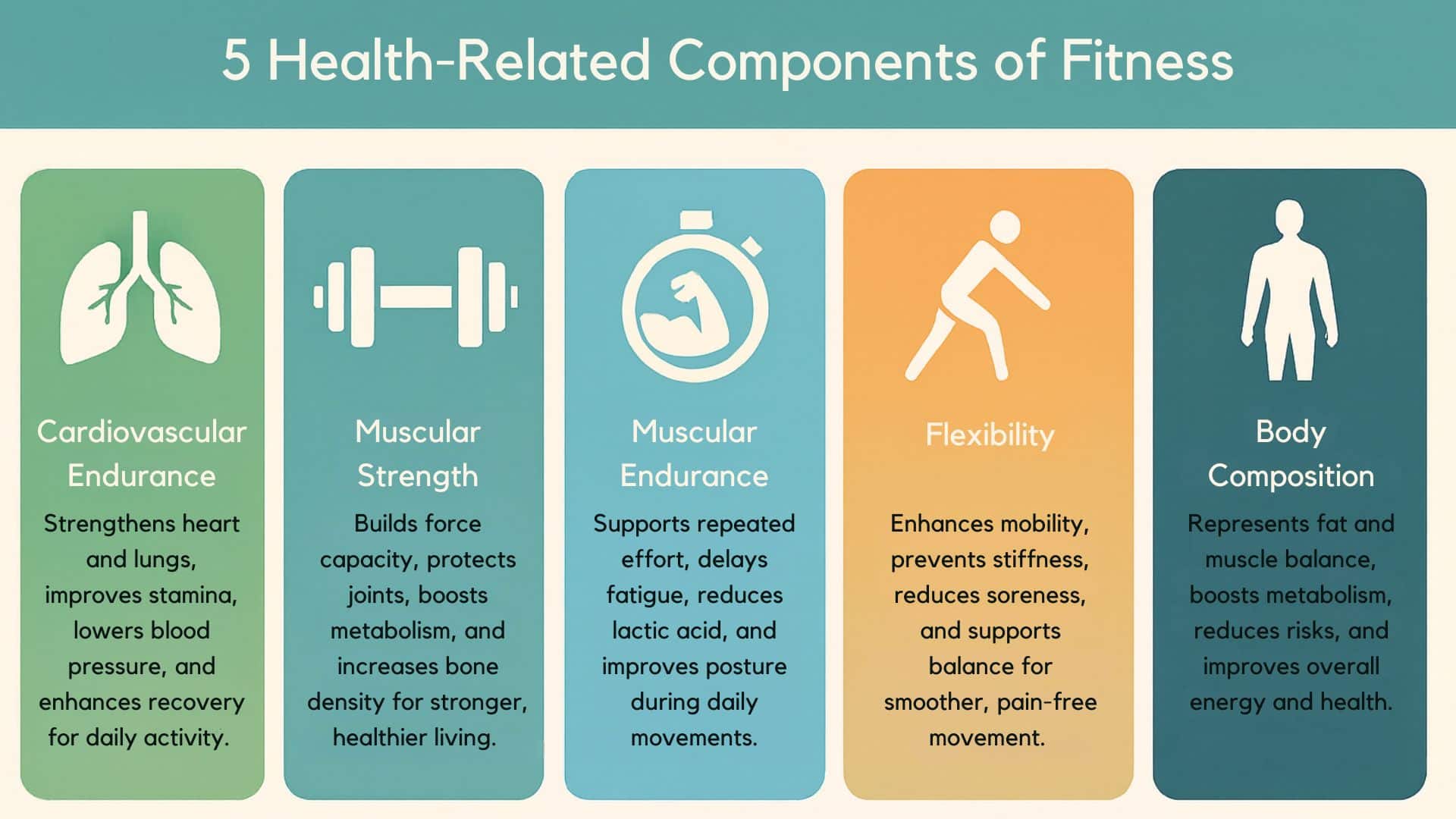Do you work out regularly but still wonder why you’re not seeing the results you want?
Most fitness enthusiasts focus on just one area and miss the bigger picture. True fitness isn’t just about lifting heavy weights or running fast.
It’s about balancing five key elements that work together for total health and wellness.
These five components act as building blocks for any fitness journey, supporting balance whether you prefer yoga, weights, or endurance training.
Having knowledge of each one helps you create a balanced program that addresses all areas of your body.
In this blog, I’ll outline the five key health-related fitness elements, explain why they matter in your daily life, and demonstrate how yoga can effectively improve each one.
5 Health-Related Fitness Components
Fitness experts have identified five core components that comprise complete health-related fitness, and each plays a vital role in your overall wellness.
1. Cardiovascular Endurance
Cardiovascular endurance measures how well your heart, lungs, and blood vessels work together during extended physical activity. This component determines your stamina levels.
Your cardiovascular system delivers oxygen and nutrients to your muscles during exercise. Better endurance means you can perform activities longer without getting tired quickly.
This fitness component affects your daily life more than you might think. Simple tasks, such as climbing stairs or walking, become easier when you improve this area.
- Heart Rate Recovery: Improves with better cardiovascular health.
- Blood Pressure: It often decreases with regular cardiovascular training.
- Recovery Speed: Faster return to normal after physical exertion.
2. Muscular Strength
Muscular strength refers to the maximum amount of force your muscles can produce in a single effort. Think of it as your muscles’ peak power output.
This component helps you lift heavy objects, push doors open, and perform daily tasks that require force. Strength training effectively builds this particular fitness element.
Strong muscles also protect your joints and bones from injury. They act as natural shock absorbers, reducing stress on your skeletal system during movement.
- Bone Density: Increases when you build muscular strength regularly.
- Metabolism: Stays higher throughout the day with more muscle mass.
- Injury Risk: Decreases when muscles properly support your joints.
3. Muscular Endurance
Muscular endurance is the ability of your muscles to perform repeated contractions over time without becoming tired. This differs from strength because it focuses on duration.
This component helps you carry groceries, hold yoga poses, or do multiple repetitions of an exercise. It’s about how long your muscles can work.
Good muscular endurance makes daily activities feel less tiring. Your muscles can handle repetitive tasks without cramping or giving out too quickly.
- Lactic Acid Buildup: Decreases with better muscular endurance training.
- Muscle Fatigue: Happens less frequently during regular activities.
- Posture: Improves when core muscles have better endurance capacity.
4. Flexibility
Flexibility measures how far your joints can move through their full range of motion. This component affects how freely your body can bend and stretch.
Good flexibility reduces muscle tension and helps prevent injuries during physical activities. It also makes movement feel more natural and comfortable for your body.
Tight muscles can limit your performance in other areas of fitness. When you improve flexibility, you often notice improvements in strength and endurance as well.
- Joint Mobility: Increases significantly with regular stretching routines.
- Muscle Soreness: Decreases when you maintain good flexibility levels.
- Balance: Improves as flexibility allows for better movement patterns.
5. Body Composition
This aspect examines the distribution of lean mass and fat, providing a clearer picture of health than weight alone.
It emphasizes body quality over scale numbers, highlighting how tissue types influence strength, metabolism, and overall health.
This component affects how you look, feel, and perform in all other areas of fitness. Better body composition often leads to improved health markers and energy.
- Muscle-to-Fat Ratio: Improves with consistent strength training and cardiovascular exercise.
- Metabolic Rate: Increases when you have more lean muscle tissue.
- Overall Health Risks: Decrease with better body composition balance.
Why These Fitness Components Matter?
The five elements are interdependent, interacting in a way that amplifies the benefits of the others, creating a more resilient and adaptable body.
Your body functions as a single, interconnected system, not a collection of separate parts. Strong muscles protect your cardiovascular system while good flexibility prevents training-interrupting muscle strains.
These components significantly affect your quality of daily life. Better cardiovascular health means increased energy at work, while good muscular strength makes household chores feel effortless.
Focusing on all five components reduces the risk of injury and illness. Each element acts as insurance for others, creating protective health networks.
Did you know? Do people who train all five fitness components have 40% fewer injuries than those focusing on single areas?
How Yoga Enhances Fitness Components?
Yoga naturally incorporates all five fitness components into one practice. This discipline builds endurance through flowing sequences while strengthening muscles through bodyweight poses.
The practice also improves flexibility through deep stretches and enhances body composition by building lean muscle. Many yoga styles incorporate cardio elements that significantly boost heart health.
- Sun salutations improve cardiovascular endurance through continuous movement.
- Warrior poses build muscular strength in the legs and core muscles.
- Holding poses develops muscular endurance throughout your entire body.
- Forward folds and twists increase flexibility in the spine and hips.
- Regular practice helps achieve a healthier body composition over time.
Yoga offers a complete fitness solution that addresses every component while being gentle on your joints and accessible to all fitness levels.
Wrapping It Up
In summary, building total wellness requires attention to all five fitness elements rather than focusing on single areas.
Your cardiovascular system, muscle power, endurance capacity, joint mobility, and body makeup work as one integrated unit.
Neglecting any element limits progress and affects daily life quality. Yoga provides an accessible path to address every element simultaneously while being gentle on joints.
This ancient practice offers flowing movements for heart health, strength poses, sustained holds for endurance, stretches for mobility, and consistent training for better body composition.
Fitness is an ongoing process, not a final destination.
Which fitness element needs the most attention in your current training, and what specific challenges are holding you back from addressing it?









